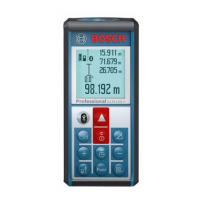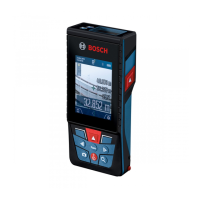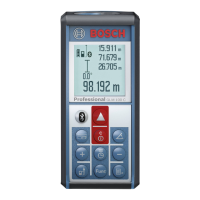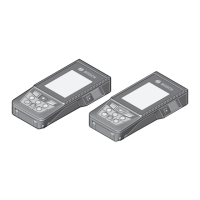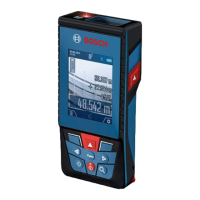16 | English
Wall area measurement (see figureF)
The wall area measurement is used to determine the sum of
multiple individual areas with a common height. In the illus-
trated example, the total area of several walls that have the
same ceiling height H but different lengths L is to be determ-
ined.
Select the wall area measurement mode .
Measure the ceiling height H as for a length measurement.
The measured value is displayed in the top measured-value
line. The laser remains switched on.
09.06.2017
13:20:23
0.0º
m
2.500
m
3.899
m
12.558
31.395 m
2
Then measure the length L
1
of the first wall.
The area is automatically calculated and dis-
played in the result line (a). The last measured
value for length can be found in the bottom
measured value line.(h). The laser remains
switched on.
Now measure the length L
2
of the second wall. The individual
measured value displayed in the measured value line (h) is
added to the length L
1
. The sum of the two lengths (dis-
played in the middle measured value line (h)) is multiplied
by the saved height H. The total area value is displayed in the
result line (a).
You can measure any number of lengths L
x
, which will be
automatically added and multiplied by the height H. The re-
quirement for a correct area calculation is that the first
measured length (for example the ceiling height H) is
identical for all sub-areas.
Stake out function (see figureG)
The stake out function repeatedly measures a defined length
(distance). These lengths can be transferred to a surface, for
example to enable material to be cut into pieces of equal
lengths or to install stud walls in a drywall construction. The
minimum adjustable length is 0.1 m and the maximum
length is 50 m.
Note: The distance from the marking is shown in the display
in the stake out function. The reference is not the edge of
the measuring tool.
Select the stake out function .
Use the button (4) [+] or the button (11) [–] to set the re-
quired length.
Begin the stake out function by pressing the measuring but-
ton (2) [ ] and slowly move away from the starting point.
The measuring tool continuously measures the
distance to the starting point. The defined
length and the current measured value are
thereby displayed. The lower or upper arrow
displays the shortest distance to the next or
last marking.
Note: When measuring continuously, you can set a meas-
ured value as a defined length by pressing the measuring
button (2) [ ].
The left factor specifies how many times the
defined length has already been reached. The
green arrows on either side of the display in-
dicate the reaching of a length for marking pur-
poses.
Red arrows or red text indicate the actual value when the ref-
erence is outside of the display.
Grade measurement/digital spirit level
Select the inclination measurement/digital spirit level .
The measuring tool automatically switches between two
states.
The digital spirit level is used to check the hori-
zontal or vertical alignment of an object (e.g.
washing machine, refrigerator, etc.).
When the inclination exceeds 3°, the ball in the
display lights up red.
The bottom of the measuring tool is used as
the reference level for the digital spirit level.
Grade measurement is used to measure a
slope or incline (e.g. of stairs, railings, when
fitting furniture, laying pipes, etc.).
The left-hand side of the measuring tool serves
as the reference level for grade measurement.
If the display flashes during measurement, the
measuring tool has been tipped too heavily to the side.
Memory functions
The value or end result of each completed measurement is
automatically saved.
Memory value display
A maximum of 50values (measured values or photos with
measured values) can be retrieved.
Select the memory function using the soft key (12) [ ] .
09.06.2017
13:20:23
30º
32.852 m
44
m
48.873
m
56.335
35.5
º
The number of the memory value is shown at
the top of the display, the corresponding
memory value and the corresponding measur-
ing function are shown at the bottom
Press the button (4) [+] to browse forwards
through the saved values.
Press the button (11) [–] to browse backwards through the
saved values.
If there is no value available in the memory, 0.000 is shown
at the bottom of the display and 0 at the top.
The oldest value is located in position 1 in the memory, while
the newest value is in position 50 (when 50 memory values
are available). When a further value is saved, the oldest
value in the memory is always deleted.
Deleting the memory
To open the memory, press the [ ] soft key (12). Press
the [ ] soft key (3) as often as required to delete the saved
measurements in reverse order. To delete all the contents of
the memory, press the [ ] soft key (3) and the zoom but-
ton (5) at the same time.
Adding/subtracting values
Measured values or end results can be added or subtracted.
Adding values
The following example describes the addition of areas: De-
termine an area as described in the section on area measure-
ment (see "Area measurement", page15).
1 609 92A 4XP | (11.01.2019) Bosch Power Tools
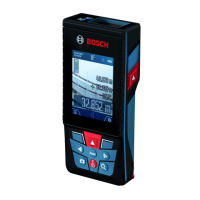
